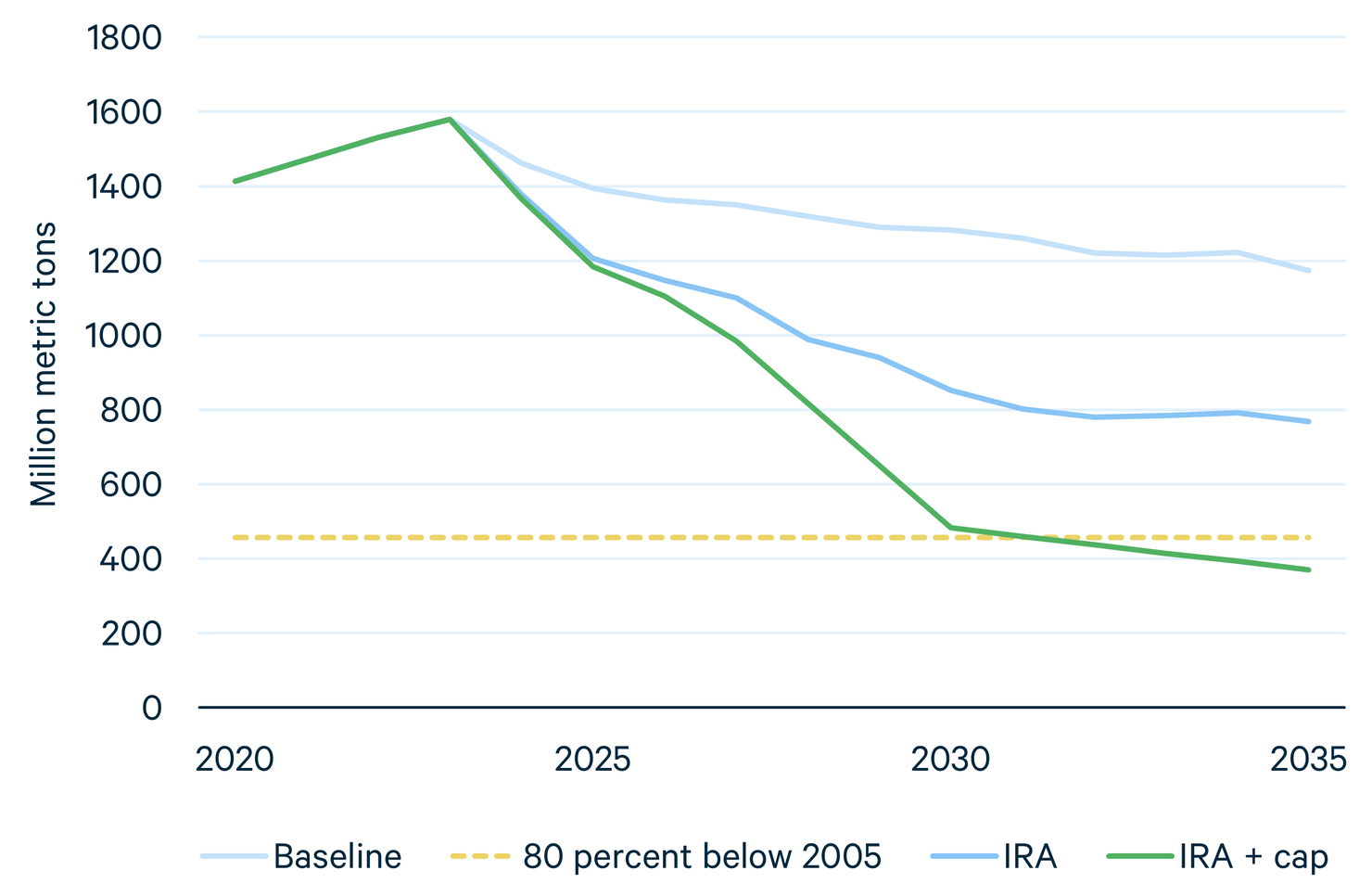Adding an Emissions Cap to the Inflation Reduction Act Could Create More Cost-Effective, Certain Emissions Reductions
💡 What’s the story?
The Inflation Reduction Act, passed in August 2022, is expected to significantly reduce carbon emissions from the power sector. However, the law alone will not be enough to drive the United States to its goal of reducing power sector emissions by 80 percent below 2005 levels by 2030 (“80x30”). What could help fill the gap?
A new working paper by a team at Resources for the Future (RFF) explores one option that could build on the progress made by the Inflation Reduction Act: a federal emissions cap. Under this policy, the federal government sets a limit on total power sector emissions and then auctions allowances to emit a portion of the year’s allowed greenhouse gas emissions. The limit, and total number of allowances the government auctions, would shrink over time to align with 80x30.
Through new modeling, the team estimates that a federal cap on power sector emissions could carry the United States to 80x30, and that such a cap would be less expensive for emitters and households than it would have been without the Inflation Reduction Act.
US Electricity Sector Carbon Emissions

Author Perspective
“Even with the Inflation Reduction Act in place, the United States will likely need additional policy to push its electricity sector to the level of emissions reductions consistent with its climate goals. An emissions cap is one way to guarantee those additional emissions reductions, and adding such a cap is cheaper than it would have been in the absence of the Inflation Reduction Act.”
— Maya Domeshek, Research Associate
🤝 How could the Inflation Reduction Act and a federal emissions cap work together?
The research team used several models to compare emissions reduction scenarios under a federal emissions cap, the Inflation Reduction Act, and a combination of the two.
The team looked at the costs and benefits of the different scenarios and how the policies would affect power sector emissions, the energy mix, net household costs, and more. The analysis revealed valuable information on how the policies work alone and in combination.
Alone, the team expects the Inflation Reduction Act to do the following:
- Create an energy-generation mix that incentivizes renewable energy generation
- Make electricity cheaper, benefiting ratepayers and low-income households
- Incur significant costs on the federal government
- Leave emissions reductions “open-ended” without a clear goal
By comparison, the RFF analysis shows that a federal emissions cap “stacked” on top of the Inflation Reduction Act to achieve 80x30 would do the following:
- Create an energy-generation mix that cuts coal-fired power plant emissions, creating substantial air quality and health benefits
- Make electricity cheaper, benefiting ratepayers and low-income households
- Earn revenues that would reduce costs to the US government
- Set a clear goal that ensures an emissions outcome
- Achieve emissions reductions at half the cost that would have been required without the Inflation Reduction Act in place
The authors emphasize that the key benefit of combining the Inflation Reduction Act with a federal emissions cap is that doing so would help meet emissions-reduction goals cost-effectively and with more certainty.
Author Perspective
“There’s not only an opportunity here to efficiently get the United States to its 80x30 goal, but there’s also an opportunity to reduce uncertainty about the future role of fossil fuels in our energy mix. If investors, policymakers, and other key players know with certainty that 80x30 is going to happen, that knowledge will help them make well-informed decisions. Those decisions, in turn, will be vital to decarbonizing the whole economy.”
—Dallas Burtraw, Senior Fellow
📚 Where can I learn more?
For more, read the working paper, “Leveraging the IRA to Achieve 80x30 in the US Electricity Sector” by RFF Research Associate Maya Domeshek, Senior Fellow Dallas Burtraw, Senior Fellow Karen Palmer, Senior Research Analyst Nicholas Roy, and Fellow Jhih-Shyang Shih.
For commentary from the authors, read the related blog post, “Adding an Emissions Cap to the Inflation Reduction Act Would Help Meet US Climate Goals,” by Maya Domeshek and Dallas Burtraw.
Resources for the Future (RFF) is an independent, nonprofit research institution in Washington, DC. Its mission is to improve environmental, energy, and natural resource decisions through impartial economic research and policy engagement. RFF is committed to being the most widely trusted source of research insights and policy solutions leading to a healthy environment and a thriving economy.
Unless otherwise stated, the views expressed here are those of the individual authors and may differ from those of other RFF experts, its officers, or its directors. RFF does not take positions on specific legislative proposals.
For more information, please see our media resources page or contact Media Relations and Communications Manager Annie Tastet.







